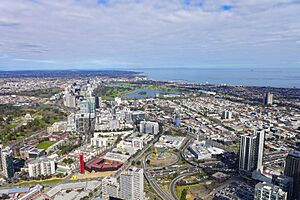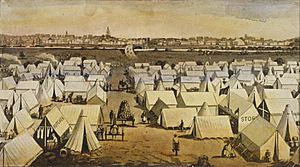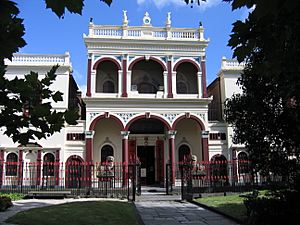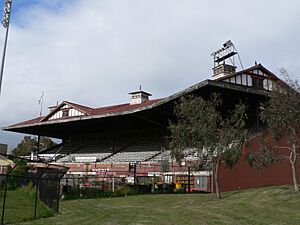South Melbourne facts for kids
Quick facts for kids South MelbourneMelbourne, Victoria |
|||||||||||||||
|---|---|---|---|---|---|---|---|---|---|---|---|---|---|---|---|

|
|||||||||||||||
| Population | 11,548 (2021 census) | ||||||||||||||
| • Density | 4,620/km2 (12,000/sq mi) | ||||||||||||||
| Established | 1840s | ||||||||||||||
| Postcode(s) | 3205 | ||||||||||||||
| Elevation | 10 m (33 ft) | ||||||||||||||
| Area | 2.5 km2 (1.0 sq mi) | ||||||||||||||
| Location | 3 km (2 mi) from Melbourne | ||||||||||||||
| LGA(s) | City of Port Phillip | ||||||||||||||
| State electorate(s) | Albert Park | ||||||||||||||
| Federal Division(s) | Macnamara | ||||||||||||||
|
|||||||||||||||
South Melbourne is a lively inner suburb located in Melbourne, Victoria, Australia. It is about 3 kilometres south of Melbourne's main city area, known as the Central Business District. This suburb is part of the City of Port Phillip local government area. In 2021, South Melbourne had a population of 11,548 people.
Long ago, South Melbourne was known as Emerald Hill. It was one of the first suburbs in Melbourne to become its own official town. It is famous for its old buildings and streets from the Victorian era, which are still well-preserved today.
Contents
History of South Melbourne

Before Europeans arrived, the area of South Melbourne was mostly flat. There was a central hill where the Town Hall now stands, surrounded by swampy land. This hill was an important meeting place for Aboriginal Australian people.
Europeans began to settle here in the 1840s, and the area became known as Emerald Hill.
The Gold Rush and "Canvas Town"
In 1851, the Victorian Gold Rush began, attracting many people to Victoria. A huge tent city called "Canvas Town" was set up in Emerald Hill. This area quickly became a very crowded place, home to thousands of people hoping to find gold.
Land in Emerald Hill started to be sold in 1852. While the main hill was kept for an orphanage, Canvas Town was soon replaced by small houses. Many of these houses were made from timber and corrugated iron, and some were even built overseas and then shipped here.
Becoming a Town and City
Emerald Hill became an official "borough" (a type of town) on 26 May 1855. This meant it was independent from the City of Melbourne. In 1857, Melbourne's second railway line, which went to St Kilda, was built through this new area.
By 1872, Emerald Hill was officially called a "town." In the 1870s, some parts of South Melbourne, especially around St Vincent Gardens, became popular places for wealthy people to live. However, most of the area had smaller, single-story houses.
The orphanage on the hill moved in 1878. The top of the hill then became the site for the South Melbourne Town Hall. This grand building was constructed between 1879 and 1880, showing how important the area had become. In 1883, Emerald Hill became a "city" and officially changed its name to South Melbourne.
Changes Over Time
In the 1950s, South Melbourne became less popular as Melbourne grew outwards. In the 1960s, the Housing Commission of Victoria built several tall public housing buildings, including Emerald Hill Court and the even taller Park Towers. These buildings housed many new migrants who came to Melbourne after the war, adding to the area's diverse culture.
In the 1980s, South Melbourne started to become popular again. Many of the old houses were renovated, and new families moved in. From the 1990s, the old industrial areas closer to the city, including Southbank, were redeveloped with new apartment buildings. In 1996, the City of South Melbourne joined with the Cities of St Kilda and Port Melbourne to form the new City of Port Phillip.
Population in South Melbourne
In the 2016 Census, there were 10,920 people living in South Melbourne. Most people (55.5%) were born in Australia. Other common birthplaces included England (4.8%), China (3.0%), and New Zealand (2.8%). English was the main language spoken at home by 66.5% of people. Many people also spoke Mandarin, Greek, or Russian.
Getting Around South Melbourne
South Melbourne is well-connected by tram routes. You can catch trams like Route 1, 12, 58, and 96. Route 96 runs along what used to be the St Kilda railway line, which was changed into a light rail line in 1987.
What to See and Do
Shopping and Cafes
The main shopping area in South Melbourne is around Clarendon Street and its side streets. This area includes the famous South Melbourne Market, where you can find many shops, cafes, restaurants, and art galleries.
Just like in Melbourne's city centre, South Melbourne has many small laneways. Most of these are paved with bluestone, a type of dark grey rock.
Homes in South Melbourne
Most of the homes in South Melbourne are Victorian-style terrace houses or semi-detached houses.
Park Towers is a well-known example of the tall public housing buildings built in South Melbourne since the 1960s. In recent years, more apartment buildings have been built, especially closer to the city in areas like Southbank.
Historic Buildings
Many of South Melbourne's Victorian-era houses and cottages are protected as heritage sites. A few original prefabricated cottages still exist, including one made of corrugated iron in Coventry Street that is now a museum.
The grand South Melbourne Town Hall, with its tall clock tower, is a famous example of Melbourne's Victorian architecture. The area around the Town Hall, built in the late 1870s and 1880s, still looks much the same today.
The See Yup Temple, built in 1856, is a Chinese temple. It is an important reminder of the Chinese people who came to Melbourne during the gold rush.
Television Studios
South Melbourne is home to television production studios owned by the Seven Network and Global Television. These studios were once the main Melbourne studios for the Seven Network. Shows like Deal or No Deal, Dancing with the Stars, and It Takes Two were filmed here.
Sports in South Melbourne
South Melbourne FC is a very successful soccer club in Australia, having won four national titles. They play at Lakeside Stadium, which was built on Lake Oval.
South Melbourne was also once home to the South Melbourne Swans, an Australian rules football team. They played at Lake Oval (now Lakeside Stadium) before moving to Sydney in 1982. This move eventually led to the creation of the national Australian Football League.
Today, Lakeside Stadium has a modern athletics track and field facility, but soccer is still played in the middle of the track.
Famous People from South Melbourne
Many notable people have lived in or come from South Melbourne, including:
- Ian Gardiner (1943–2008), an artist known for woodcut prints.
- George King (1892–1976), an Australian rules footballer.
- John Reid "Gentleman Jack" McGowan (1872–1912), a champion boxer.
- Herbert Henry "Dally" Messenger (1883–1959), a champion rugby footballer.
- Russell Mockridge (1928–1958), an Olympic gold medallist in cycling.
- Bob Skilton (1938–present), an Australian rules footballer.
- William John Wills (1834–1861), a pioneering explorer who was part of the famous Burke and Wills expedition.







